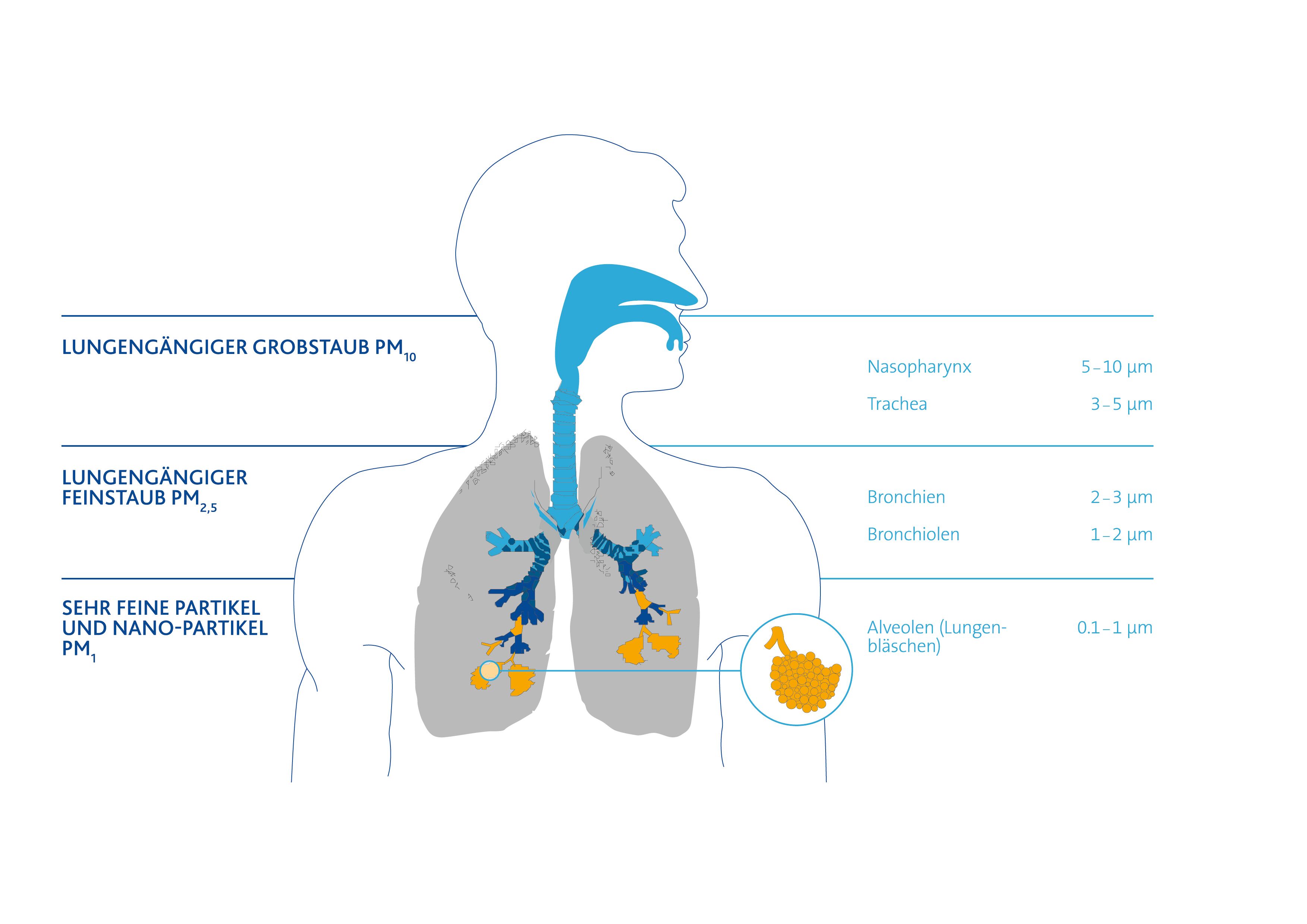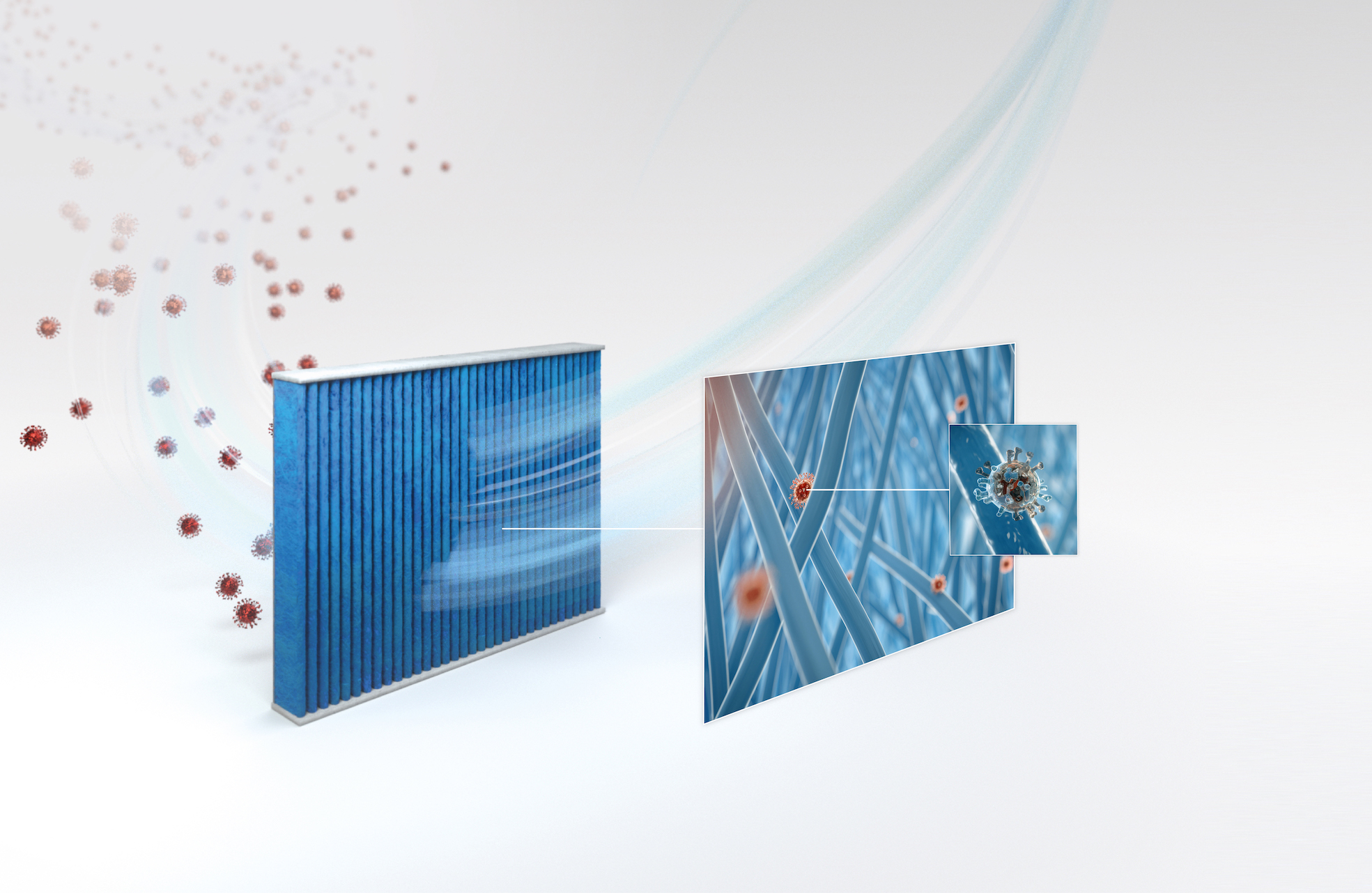Freudenberg Filtration Technologies
Coronavirus thwarted: with filters against aerosol spread
Filter technology can effectively remove microorganisms such as the new type of coronavirus from the air - even in aerosols. A team of experts at Freudenberg Filtration Technologies develops and produces filtration solutions that effectively reduce the spread of viruses in cars, industrial plants and public buildings. The company’s filter technology for reducing the viral load is a reliable method for enabling people to stay in closed rooms with a high density of people.
In addition to airborne virus-laden droplets, aerosols are thought to be the main ways the novel coronavirus spreads. This is down to the observation that a large number of SARS-CoV-2 virus infections occur in people who have not been in close contact1-3. There is a continuum of droplet sizes: larger droplets develop into aerosols through evaporation; they can develop into aerosolised particles significantly smaller than 5 µm in size through people speaking, breathing, coughing or sneezing. Rather than falling to the ground, these suspended particles are distributed in the room with the air flow and the infectious coronaviruses they contain can thus reach other people.
Virus-laden droplets and aerosols
-
-
-
-
Dr. Thomas Caesar, Director Global Filter Engineering der Division Industrial Filtration, Freudenberg © Freudenberg Filtration Technologies
Volker Bräunling, Global Technical Director der Division Automotive Filters, Freudenberg © Freudenberg Filtration Technologies
In principle, the probability of transmission of droplets and aerosols increases within a radius of one to two metres around an infected person. However, since aerosols with trapped infectious virus particles remain suspended in the air for a long time and spread in closed rooms just like cigarette smoke does, it is now thought that people can become exposed to the virus at distances greater than two metres from each other4. In addition to the duration of exposure, viral load also plays a role.
This requires a new way of thinking, in addition to prevention measures for limiting the spread of the virus such as hand hygiene, wearing face masks and distancing rules. Reducing exposure to the virus is essential, especially in enclosed spaces, to keep infection levels low. Here, effective air exchange and ventilation systems are a good solution.
This is where the Freudenberg Group comes in. One of the mainstays of the Weinheim-based company - in addition to products for sealing and vibration control technology, nonwovens, specialty chemicals and medical technology - is air and water filtration.
 Deposition of particles in the respiratory tract in relation to particle size. The classification of particles into PM categories is based on the National Air Quality Standard for Particulate Matter (PM) as established by the US Environmental Protection Agency (EPA). PM10 filters are used for particles smaller than 10 µm (e.g. pollen, dust), PM2.5 filters for particles smaller than 2.5 µm (e.g. bacteria), PM1 filters for particles smaller than 1 µm (e.g. viruses). © Freudenberg Filtration Technologies
Deposition of particles in the respiratory tract in relation to particle size. The classification of particles into PM categories is based on the National Air Quality Standard for Particulate Matter (PM) as established by the US Environmental Protection Agency (EPA). PM10 filters are used for particles smaller than 10 µm (e.g. pollen, dust), PM2.5 filters for particles smaller than 2.5 µm (e.g. bacteria), PM1 filters for particles smaller than 1 µm (e.g. viruses). © Freudenberg Filtration Technologies"For more than 60 years, we have been using our filters at our customers' sites and providing maintenance services to ensure consistent quality and safety – the filters are tailored to each individual customer and application," explains Dr. Thomas Caesar, Director Global Filter Engineering of the Industrial Filtration Division.
The novel coronavirus, which can be up to 0.16 µm in size, is not present as a single particle, but enclosed in aerosols or droplets and is relatively stable up to around 38 °C and 95% humidity. "But even the largest droplets shrink quickly to a size of less than 1 μm through evaporation. Therefore, general ventilation and air conditioning systems require filters of at least class ePM1, i.e. filters that are highly effective in retaining particles smaller than 1 µm", says Karsten Schulz, Manager Product Segment Engineering/Filter Engineering.
Reducing the risk of viral disease with cabin air filters
"The smallest particles can be easily inhaled, especially in the limited space of a car or bus, while larger particles settle on plastic surfaces, steering wheels and upholstery, where viruses remain infectious for up to several hours. As we are driving, they can become detached by vibration and form aerosols again," explains Volker Bräunling, Global Technical Director of the Automotive Filters Division.
 The four-layer cabin air filter developed by Freudenberg first separates particles and viruses (e.g. SARS-CoV-2) and then inactivates them via a fruit extract which destroys the viruses’ protein envelope. © Freudenberg Filtration Technologies
The four-layer cabin air filter developed by Freudenberg first separates particles and viruses (e.g. SARS-CoV-2) and then inactivates them via a fruit extract which destroys the viruses’ protein envelope. © Freudenberg Filtration TechnologiesThe solution? "In addition to ensuring the highest possible air exchange rate in the vehicle cabin and minimising the proportion of recirculated air, installing a highly efficient cabin air filter in the ventilation system provides extremely effective protection. We have been able to demonstrate this for our micronAir proTect line". This four-layer filter consists of two layers of filters which separate the finest particles less than 1 μm in size, and hence adhering viruses, an activated carbon layer that cleans the exhaust gases, and a fourth layer that additionally provides surface protection in the form of a functional fruit extract. "In addition to allergens, bacteria and fungi, the fourth layer also inactivates viruses that pass through the particle filter layers and whose protein shell is then destroyed by the functional surface," explains Bräunling.
The impregnation with fruit extract was successfully tested with the influenza A virus H1N1 and the cold virus HCoV-229E. According to the ISO 18184 test, Freudenberg Filtration Technologies can demonstrate an inactivation rate of over 99.9 percent for these viruses. "We are currently conducting intensive scientific studies with specialist institutes to test automotive cabin air filters for both physical retention and downstream virus inactivation. We are using the smallest virus species (bacteriophages) and simulating the real situation during filtration on the laboratory scale. The filters are exposed to virus-contaminated air, particle counters measure the physical separation efficiency and the clean air is additionally microbiologically analysed for active viruses."
Removing SARS-CoV-2 from the air in larger rooms
Even in larger rooms, the risk of virus spread can be reduced in a building ventilation system using effective filtration measures. "Air filters of different filter classes are combined in a multi-stage system to ensure the desired indoor air quality. This allows us to match the most efficient filter solution to the customer’s specific requirements," says Caesar. The filter stages are optimally matched to each other, and are tested in accordance with the ISO 1689 standard5, which determines separation efficiency on the basis of dust categories and is based on the evaluation parameters used by the World Health Organisation, amongst others.
"The proportion of fresh air should be as high as possible to prevent the spread of pathogens via the circulating air. If the circulating air in a ventilation system cannot be eliminated, it is recommended to filter this air through specific HEPA filters or at least through high-arrestance filters. Filter systems with a greater degree of arrestance are not recommended, as they can increase overpressure in the ventilation system and thus increase the likelihood of unfiltered air leaking out," says Caesar.
HEPA filters are standard in cleanrooms in the pharmaceutical and food industries and hospitals. Class H14 HEPA (high-efficiency particulate air) filters matched with each other trap at least 99.995 percent of particles, bacteria and viruses of approximately 100 nm in size - including coronaviruses. HEPA filters are specifically tested and classified. Values relating to local separation efficiency and overall separation efficiency are measured in accordance with the EN 1822 test standard, in each case for the most difficult particle size to be separated (MPPS, most penetrating particle size). "Both the fractional collection efficiency curve and MPPS depend on filter medium and air velocity and must therefore be determined product-specifically," says the expert. The tiniest leaks in the material or in the sealing between filter medium and frame can lead to locally increased penetration and thus particle accumulation on the clean air side. For this reason, HEPA/ULPA filters are subjected to individual leak tests.
Service also part of the concept
In addition to pure filtration products, Freudenberg also offers tailor-made service solutions. Ventilation systems that are well maintained, hygienically perfect and equipped with highly effective air filters make a valuable contribution to this. In the current coronavirus situation, Freudenberg Filtration Technologies has added two new hygiene modules to its Viledon filterCair air quality management system. Both include a ventilation system check to protect employees from infections and food from contamination, and thus protect companies from the economic consequences of temporary closure.
"In the long run, cost-savings can be made if the filters are not only adapted to the application but also to local fine dust pollution," explains Caesar. There is increasing evidence that higher levels of air pollution lead to more severe disease6,7.
Filter technology will therefore continue to become increasingly relevant in the future. In the context of infection control, it offers – in addition to its previous use in clinics and industry – a solution for reducing the risk of infections associated with the accumulation of people in indoor public spaces.